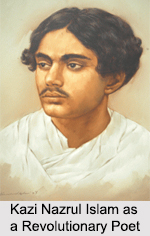 Kazi Nazrul Islam as a Revolutionary Poet emerged with numerous poems, songs, ballads, stories and essays poured from his pen in rapid succession. He was a symbol of revolution and hope against fascism and oppression. His poetry and revolutionary songs and nationalist activism earned him the title of "Bidrohi Kobi" (Rebel Poet). In 1921, Kazi Nazrul Islam published his seminal poem titled "Bidrohi" (The Rebel). The poem immediately established his identity as a countercultural maestro of impassioned verses. His revolutionary songs played an important role during the Liberation War.
Kazi Nazrul Islam as a Revolutionary Poet emerged with numerous poems, songs, ballads, stories and essays poured from his pen in rapid succession. He was a symbol of revolution and hope against fascism and oppression. His poetry and revolutionary songs and nationalist activism earned him the title of "Bidrohi Kobi" (Rebel Poet). In 1921, Kazi Nazrul Islam published his seminal poem titled "Bidrohi" (The Rebel). The poem immediately established his identity as a countercultural maestro of impassioned verses. His revolutionary songs played an important role during the Liberation War.
Kazi Nazrul Islam is a secular icon for his works for mass people regardless of their religious beliefs, socio-economical position, and gender. He expressed his beliefs of harmony through poems and songs. Yet, his poems and songs on love remained just as tender, melodic and heartbreaking.
Contributions of Kazi Nazrul Islam as a Revolutionary Poet
Kazi Nazrul Islam"s first contribution was "Baadhan Hara" (Unrestrained), a novel in the form of letters. Among his contributions in the first year were some outstanding poems like "Shatil Arab", an ode to the river of that name, "Moharram", "Korbani", "Fatiha Doazdaham", "Badal Prater Sharab" (Wine for a Rainy Morning), an allegory entitled "Badal Barishane" (While it Rained) and other poems and songs. A poem entitled "Kheya Parer Tarani` (Ferry Boat) is a wonderful combination of sublimity with resonant rhyme. Kazi Nazrul Islam is known to have received inspiration for writing this poem from a painting of a boat by a lady of a distinguished family of Dhaka, Bangladesh.
Kazi Nazrul Islam took to Political Journalism. He had left school and joined the army also with the political motive of service to his country. In 1920, he made his first debut in Political Journalism. It was a period of intense stress and tension. The people"s anger at the Jallianwala Bagh Massacre and other violence in the Punjab in 1919 led to the launching of the Non-Cooperation Movement under the leadership of Mahatma Gandhi. Kazi Nazrul Islam joined the Bengali evening daily "Nabayug" (The New Era) founded by the well-known leader A.K. Fazlul Huq. "Upasana" and "Saogat" are the other monthlies for which Nazrul wrote at the time. While working for "Nabayug" and though busy writing political editorials, Nazrul produced many remarkable poems. His writings at the time were later collected in a book entitled "Yugabani" (Message of the Age); but the book was immediately banned by the Government.
The Non-Cooperation Movement was on and Kazi Nazrul Islam celebrated the epochal arrival of Mahatma Gandhi. Nazrul wrote a Satya Mantra (the Mantra of Truth):
"Let the injunctions in your books be burnt down; Let God"s injunctions prevail"
Kazi Nazrul Islam also wrote many lyric pieces inspired by sentiment for those dear and near to him. "Banglar Katha", Nazrul wrote for the paper, a remarkable poem which could also be sung. It is entitled “Bhangar Gaan†(the Song of Destruction).
The crowning moment of his poetic career had come in 1921, when Kazi Nazrul Islam wrote the long and virile poem "Bidrohi" (the Rebel) which at once established him as a major poet. The poem caused an unprecedented sensation but also an adverse reaction among some of his literary contemporaries. Rabindranath Tagore and Sarat Chandra Chatterjee welcomed the new poet into the literary firmament of Bengal.
In 1922 while writing for "Sevak" Kazi Nazrul Islam planned and published a political weekly called "Dhumketu" (The Comet). The paper`s revolutionary fervour made a great impact on the educated middle class. Dhumketu was thus a hallmark of Kazi Nazrul Islam`s politico-literary career. It stood openly for complete independence from British rule and soon got into trouble with the Government. In 1923, Nazrul was arrested for a poem named "Anandamayeer Agamane" (on the advent of the Goddess of Happiness) that was published in one of the issues of the paper. He was tried and sentenced to one year`s rigorous imprisonment. While in jail Kazi Nazrul Islam composed a number of romantic poems, most outstanding among which was "Pujarini" (The Woman Worshipper). After his release from jail Nazrul, plunged into politics again and collaborated in founding Labour Swaraj Party of the Indian National Congress. He became the director of a new weekly called "Langal" (The Plough). He composed and published in Langal, a compact series of poems called "Samyabadi" (Song of Equality).
Kazi Nazrul Islam went to Krishnanagar, where a number of conferences were held at Krishnanagar at that time and in each of them Nazrul sang songs, composed by him, suitable for the occasion. It was at that conference he sang "Kandari Hushiar" (Helmsman, Beware) which has since taken its place in Bengal as a chorus song of unparalleled fervour. He composed 2 novels at Krishnagar, "Kuhelika" (Fog) and "Mrityu-Kshudha" (Hunger for Death).
In 1926, communal riots had broken out in Calcutta (now Kolkata) and Kazi Nazrul Islam reacted strongly in a number of articles published in "Ganabani". The poems were later collected in the book "Phani-Manasha" (Thorny Cactus) and the articles were later collected and published in a book called "Rudra Mangal" (To the Terrible God).
A public reception was accorded to Kazi Nazrul Islam in Calcutta in the middle of 1929. Acharya Prafulla Chandra Ray, the eminent scientist and Subhas Chandra Bose paid a remarkable tribute to Kazi Nazrul Islam and his soul-stirring poems and songs.













